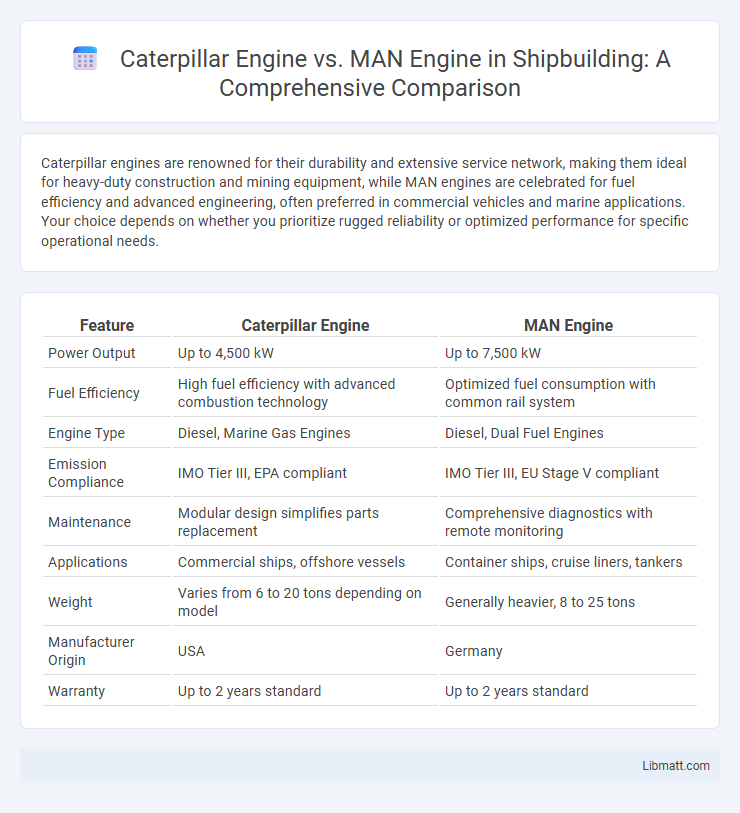Caterpillar engines are renowned for their durability and extensive service network, making them ideal for heavy-duty construction and mining equipment, while MAN engines are celebrated for fuel efficiency and advanced engineering, often preferred in commercial vehicles and marine applications. Your choice depends on whether you prioritize rugged reliability or optimized performance for specific operational needs.
Table of Comparison
| Feature | Caterpillar Engine | MAN Engine |
|---|---|---|
| Power Output | Up to 4,500 kW | Up to 7,500 kW |
| Fuel Efficiency | High fuel efficiency with advanced combustion technology | Optimized fuel consumption with common rail system |
| Engine Type | Diesel, Marine Gas Engines | Diesel, Dual Fuel Engines |
| Emission Compliance | IMO Tier III, EPA compliant | IMO Tier III, EU Stage V compliant |
| Maintenance | Modular design simplifies parts replacement | Comprehensive diagnostics with remote monitoring |
| Applications | Commercial ships, offshore vessels | Container ships, cruise liners, tankers |
| Weight | Varies from 6 to 20 tons depending on model | Generally heavier, 8 to 25 tons |
| Manufacturer Origin | USA | Germany |
| Warranty | Up to 2 years standard | Up to 2 years standard |
Overview of Caterpillar and MAN Engines
Caterpillar engines are renowned for their durability and advanced fuel efficiency, commonly used in heavy construction, mining, and marine applications. MAN engines, produced by the German manufacturer MAN Energy Solutions, are favored for their innovative design and high power output, widely deployed in commercial vehicles and power generation. Both brands utilize cutting-edge technology to optimize performance and emissions, making them leaders in the global diesel engine market.
Engine Design and Technology Comparison
Caterpillar engines utilize advanced ACERT technology, offering precise fuel combustion and reduced emissions, while MAN engines are known for their innovative Turbocharging and Exhaust Gas Recirculation (EGR) systems that enhance fuel efficiency and lower NOx emissions. Both manufacturers employ robust design elements, with Caterpillar emphasizing modular components for easier maintenance and MAN focusing on lightweight materials to improve power-to-weight ratios. Your choice between these engines depends on prioritizing either Caterpillar's proven durability and maintenance simplicity or MAN's cutting-edge fuel economy and emission control technologies.
Performance and Power Output
Caterpillar engines are renowned for their high torque and reliable power output, delivering consistent performance in heavy-duty applications with horsepower ranging from 50 to over 4,000 HP. MAN engines excel in fuel efficiency and low emissions while providing robust power suited for marine and industrial use, with power outputs typically between 200 and 2,000 HP. Both brands incorporate advanced technologies for enhanced durability and optimized combustion, ensuring superior performance tailored to demanding operational requirements.
Fuel Efficiency and Consumption
Caterpillar engines are renowned for their advanced fuel injection technology and optimized combustion processes, resulting in superior fuel efficiency across heavy-duty applications. MAN engines leverage turbocharging and precise fuel management systems to reduce fuel consumption while maintaining high performance and low emissions. Both brands prioritize fuel economy, but Caterpillar's integration of electronic controls often provides a slight edge in optimizing fuel usage under varying operational conditions.
Reliability and Durability
Caterpillar engines are renowned for their exceptional reliability, featuring robust construction and advanced cooling systems that ensure consistent performance under heavy workloads. MAN engines emphasize durability with innovative engineering and high-strength materials designed for long service intervals and resistance to wear in demanding environments. Your choice between Caterpillar and MAN will depend on the specific operational needs, as both brands deliver superior engine longevity and dependable power output.
Maintenance Requirements and Costs
Caterpillar engines typically feature advanced diagnostic systems that streamline maintenance processes and reduce downtime, though their proprietary parts can result in higher replacement costs. MAN engines are known for robust engineering with longer service intervals, which can lower routine maintenance expenses, but may require more frequent oil changes under heavy loads. Both brands demand skilled technicians for optimal upkeep, yet Caterpillar's widespread service network often provides more accessible maintenance support globally.
Engine Applications and Industries
Caterpillar engines dominate heavy machinery sectors such as construction, mining, and agriculture due to their robust design and high power output, making them ideal for earth-moving equipment and industrial generators. MAN engines are widely favored in commercial transportation and marine industries, powering trucks, buses, and shipping vessels with advanced fuel efficiency and emission control technologies. Both brands serve energy production applications, but Caterpillar is more prominent in portable and stationary power generation, while MAN excels in large-scale marine propulsion and heavy-duty commercial vehicles.
Environmental Impact and Emissions
Caterpillar engines utilize advanced combustion technology and exhaust aftertreatment systems to meet stringent emission standards, significantly reducing nitrogen oxides (NOx) and particulate matter (PM) output. MAN engines incorporate similar emission control technologies, including selective catalytic reduction (SCR) and exhaust gas recirculation (EGR), optimizing fuel efficiency while minimizing environmental impact. Choosing between these engines can influence your carbon footprint, as both manufacturers prioritize sustainable performance aligned with global environmental regulations.
Parts Availability and After-Sales Support
Caterpillar engines benefit from an extensive global network ensuring high parts availability and rapid delivery, minimizing downtime in critical applications. MAN engines offer robust after-sales support through a comprehensive service network and tailored maintenance programs, enhancing engine longevity and performance. Both Caterpillar and MAN prioritize customer service, but Caterpillar's widespread distribution channels often provide a slight edge in parts accessibility worldwide.
Pricing and Value for Money
Caterpillar engines generally command higher prices due to their robust build quality, advanced technology, and extensive global service network, offering strong long-term value through durability and fuel efficiency. MAN engines provide competitive pricing with slightly lower upfront costs while maintaining reliable performance and easier maintenance, making them a cost-effective option for budget-conscious buyers. Evaluating total cost of ownership, including fuel consumption, maintenance, and resale value, is crucial to determining the best value for money between Caterpillar and MAN engines.
Caterpillar engine vs MAN engine Infographic

 libmatt.com
libmatt.com